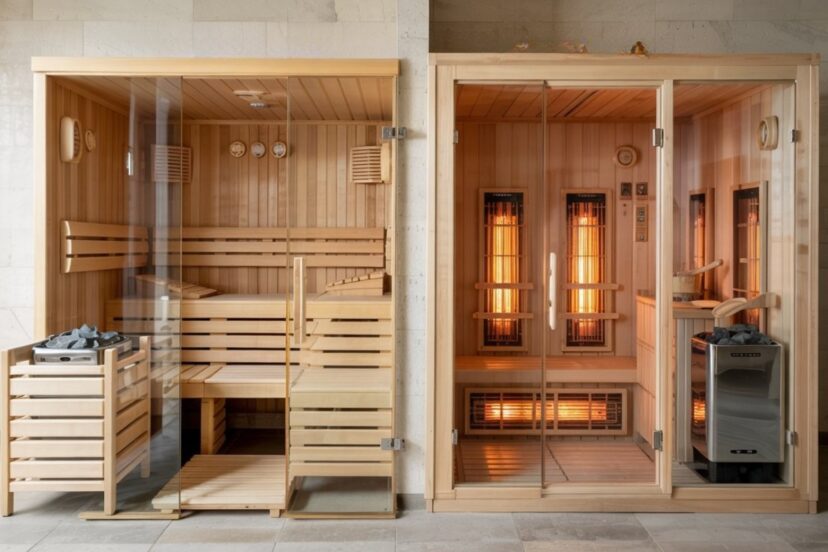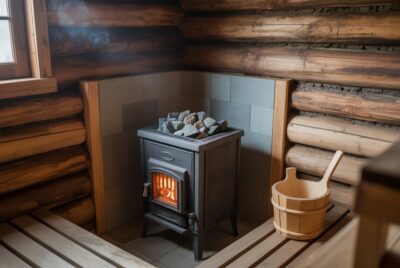Infrared vs. Traditional Sauna
*We may earn a commission for purchases made using our links. Please see our disclosure to learn more.
Stepping into the warm embrace of a sauna has been a cherished ritual across cultures for centuries. Whether it’s the Finnish tradition of löyly or the Japanese practice of mokusō, humans have long recognized the therapeutic potential of heat therapy. Today, the wellness landscape presents two distinct paths to this ancient practice: the time-honored traditional sauna and its modern counterpart, the infrared sauna.
While both promise sweat-inducing sessions and numerous health benefits, they function on entirely different principles and create unique experiences. This article delves into the science, benefits, and practical considerations of each option—infrared vs. traditional sauna—to help you discover which sauna experience aligns best with your wellness journey.
Key Takeaways
- Heat Mechanism: Traditional saunas heat the air around you (convection heat), while infrared saunas directly warm your body tissues using infrared light waves.
- Temperature Experience: Traditional saunas operate at higher temperatures (170-200°F) with 5-20% humidity; infrared saunas work at lower temperatures (120-150°F) with minimal humidity.
- Physiological Effects: Traditional saunas create intense surface sweating; infrared heat penetrates deeper (1.5-2 inches) into tissues and joints.
- Energy Efficiency: Infrared saunas typically use 30-50% less electricity and heat up in 15-20 minutes versus 30-60 minutes for traditional models.
- Installation Requirements: Traditional saunas often need dedicated space and sometimes plumbing; infrared models plug into standard outlets and require minimal setup.
- Health Benefits: Both types support detoxification, cardiovascular health, muscle recovery, and stress reduction, though through different physiological pathways.
“Heat is a deeply intuitive therapy—the body naturally craves warmth for healing. Both traditional and infrared saunas tap into this fundamental relationship between heat and wellness, though they do so through fascinatingly different mechanisms.”
— Dr. Rhonda Patrick, Ph.D., heat therapy researcher and founder of Found My Fitness
Top Recommended Saunas
For Traditional Sauna Enthusiasts:
Canadian Red Cedar Wood Swedish Sauna
Elevate your wellness experience with the luxurious Canadian Red Cedar Wood Swedish Sauna. Perfect for indoor use, this sauna comfortably fits 4 to 6 people, making it an ideal choice for relaxation with friends or family. Crafted from premium Canadian Red Cedar, it ensures long-lasting durability while creating an inviting, aromatic atmosphere. The sauna features a powerful 9KW wet/dry heater, a digital control panel, and a range of essential accessories including rocks, a water bucket, ladle, sand timer, thermometer, and interior lighting for an authentic spa experience.
- Premium Cedar Wood: Made from Canadian Red Cedar, known for its durability and aroma.
- Versatile Size: Fits 4 to 6 people with dual-level benches for added comfort.
- All-Inclusive Package: Includes heater, rocks, bucket, ladle, and more for a complete sauna experience.
- Installation Required: Requires professional installation by a licensed electrician for setup.
- Large Footprint: Requires adequate space for setup, especially considering its weight and size.
- Shipping: Ships flat packed, requiring assembly once received.
The Canadian Red Cedar Wood Swedish Sauna combines authentic design with high-quality craftsmanship. Made from premium Canadian Red Cedar, this sauna offers a timeless and durable construction that enhances its aromatic appeal. Featuring a powerful 9KW electric heater, it heats up to 190°F in approximately 45 minutes. Ensuring a fast and effective warming experience.
The spacious interior comfortably accommodates 4 to 6 adults, with ergonomic backrests on dual-level benches for ultimate relaxation. This sauna also comes equipped with premium accessories, including rocks, a water bucket, ladle, sand timer, thermometer, and interior lighting. Ensuring a complete and authentic spa experience right at home.
Harvia KIP 8KW Electric Sauna Heater
The Harvia KIP 8KW Electric Sauna Heater is a sleek and powerful option for any home sauna. Featuring a stunning stainless steel design, this heater is perfect for residential use and can efficiently heat an area between 247-424 cubic feet. Equipped with built-in controls for easy temperature adjustment, it provides a seamless and enjoyable sauna experience. This model includes premium sauna stones, ensuring even heat distribution throughout the session. With a power requirement of 33.3 AMPS, this electric heater is a reliable and high-performing addition to any home spa setup.
- Sleek Design: Beautiful stainless steel construction adds a modern touch to your sauna.
- Built-In Controls: Convenient, easy-to-use temperature controls are integrated into the heater.
- Premium Accessories Included: Comes with sauna stones for optimal heat distribution and performance.
- Curbside Delivery: Requires curbside delivery, and additional arrangements may be needed for on-site placement.
- Power Requirements: Requires a 33.3 AMPS electrical connection, which may need professional installation.
- Limited Coverage Area: Suitable for heating spaces between 247-424 cubic feet, so larger saunas may require a different model.
The Harvia KIP 8KW Electric Sauna Heater is a commercial-grade option designed to elevate your sauna experience, ideal for existing sauna rooms ranging from 247 to 424 cubic feet. With a built-in digital control panel, this heater offers easy adjustments for temperature and a timer. Alongside essential safety features for a secure and enjoyable session.
Constructed from durable stainless steel, it includes an integrated stone compartment with a 65 lbs capacity for even heat distribution. The floor-standing design is equipped with a protective exterior that stays cooler to the touch, ensuring safe use while enhancing the overall aesthetic of your sauna space.
For Infrared Sauna Seekers:
SWHSE Full Spectrum Infrared Sauna
Transform your home into a wellness retreat with the Full Spectrum Infrared Sauna. Designed for 2-3 people, this indoor dry sauna combines cutting-edge technology with natural healing properties. Equipped with 6 heating tubes and 3 carbon plates, the sauna provides rapid and customizable warmth, increasing heating speed by 150%. The Himalayan salt panel adds a touch of tranquility, releasing negative ions to reduce stress, promote better sleep, and enhance relaxation. Constructed with premium Canadian hemlock wood, it promises durability and superior thermal insulation, ensuring your sauna remains a staple for years to come.
- Himalayan Salt Panel: Promotes wellness with negative ions that reduce stress and improve sleep quality.
- Rapid Heating System: Features a carbon tube heating system that heats up 150% faster, with individual control for customized zones.
- Durable Construction: Made with premium Canadian hemlock wood, ensuring longevity and excellent thermal insulation for up to 15 years.
- Large Size: May require significant space in your home, suitable for 2-3 people.
- Requires Setup: Requires delivery via truck and confirmation of details before shipping.
- Bluetooth Connectivity: While great for entertainment, it adds complexity and may not be desired by users who prefer a simpler experience.
The Full Spectrum Infrared Sauna features advanced infrared technology, offering near, mid, and far infrared wavelengths for a complete and therapeutic sauna experience. Equipped with low-EMF carbon heating panels, it ensures safe and efficient heat distribution while enhancing the relaxation benefits. The sauna is also designed with chromotherapy lighting, allowing users to benefit from the calming effects of color therapy.
With Bluetooth audio connectivity, you can enjoy your favorite music or podcasts, creating an immersive environment. The intuitive control panel makes it easy to adjust settings, while the sauna comfortably accommodates 2 people. Built with sustainable Canadian hemlock, it combines durability with natural beauty, ensuring a long-lasting and eco-friendly addition to your wellness routine.
Golden Wave Meta Chamber Infrared Sauna Dome
Transform your home into a personal spa with the Golden Wave Meta Chamber Infrared Sauna Dome. This innovative sauna dome uses far infrared technology to provide a soothing and therapeutic heat experience with two independently controlled heating zones. The combination of nano carbon and ceramic heating elements ensures even heat distribution, enveloping your body in full-body warmth from 7 heating pads – 5 within the dome and 2 inside the mat. The sauna reaches temperatures ranging from 110 to 150 degrees Fahrenheit and offers powerful detoxifying benefits.
- Portable and Compact: Easy to set up and move, ideal for limited space in your home.
- Full-Body Heating: 7 heating pads provide an even and comprehensive heating experience.
- Dual Temperature Control: Independent heat zones with separate timers for customizable comfort.
- Single User Capacity: Designed for just one person, limiting its use for multiple individuals at once.
- Initial Setup: Requires minimal assembly, but setup might still take a few minutes for some users.
- Head Outside Design: While beneficial for comfort, having the head outside may limit the full-body heat experience for some users.
The Golden Wave Meta Chamber Infrared Sauna Dome features a personal-sized design tailored for focused infrared exposure, allowing you to enjoy targeted therapeutic heat. It comes with a memory foam comfort pad, complete with a washable cover, ensuring a cozy and hygienic experience every time.
The sauna offers programmable sessions, including 6 different wellness programs, allowing you to customize your sauna experience for maximum relaxation and health benefits. Equipped with ultra-low EMF technology, it uses patented Solocarbon® heating technology to provide efficient and safe heat, ensuring a peaceful and rejuvenating session every time.
The Science Behind Traditional Saunas
Traditional saunas, also called Finnish saunas, operate on a straightforward principle: they heat the air around you, which in turn heats your body. This convection-based approach typically uses electric heaters, wood-burning stoves, or heated stones to raise ambient temperatures to between 170°F and 200°F (75-95°C).
The traditional sauna experience unfolds in several distinct phases. First, there’s the initial dry heat phase where your body begins to warm. Then comes the löyly, the moment when water is ladled onto hot stones, creating a burst of steam that raises humidity and intensifies the heat sensation. This alternating pattern between dry and humid heat creates the quintessential traditional sauna experience.
When you enter a traditional sauna, your skin temperature quickly rises to about 104°F (40°C). This triggers your sympathetic nervous system, dilating blood vessels and increasing heart rate. Blood rushes to the surface of your skin as your body works to cool itself, and you begin to sweat profusely. A typical 20-minute session can produce up to a liter of sweat.
The high heat environment creates what scientists call “beneficial stress” or hormesis, a biological phenomenon where exposure to moderate stress triggers adaptive responses that strengthen your system. This includes the release of heat shock proteins that help repair damaged cellular proteins and enhance cellular resilience.
The Science Behind Infrared Saunas
Infrared saunas work on a fundamentally different principle. Rather than heating the air around you, they emit infrared radiation—invisible light waves just beyond the red end of the visible spectrum—that directly penetrate and warm your body tissues. This radiant heat can reach 1.5-2 inches below the skin’s surface, warming you from the inside out.
Infrared saunas typically operate at lower temperatures between 120-150°F (50-65°C), making them more tolerable for many users while still inducing therapeutic sweating. There are three categories of infrared wavelengths, each with distinct properties:
- Near-infrared (NIR, 0.8-1.5 μm): Penetrates the shallowest but may support skin renewal and wound healing
- Mid-infrared (MIR, 1.5-3 μm): Reaches deeper into soft tissues, potentially aiding circulation and reducing inflammation
- Far-infrared (FIR, 3-1000 μm): Penetrates deepest, creating a resonance with water molecules in the body that generates heat
Full-spectrum infrared saunas incorporate all three wavelength ranges, while many models focus primarily on far-infrared, which most effectively creates the sensation of deep, penetrating heat. The infrared approach allows your core body temperature to rise while in a more comfortable ambient environment, which some users find allows for longer sessions and deeper relaxation.
Comparing Health Benefits
Both sauna types offer impressive health benefits, though they may work through slightly different mechanisms due to their distinct heating approaches. Infrared vs. traditional sauna—the traditional sauna uses heated air to warm your body, typically reaching temperatures between 150°F to 195°F, while the infrared sauna employs infrared heaters to directly warm your body through infrared light at lower temperatures, usually around 120°F to 140°F.
This difference in heating method can affect the intensity and depth of the heat, as well as the overall experience, making each sauna type unique in how it promotes relaxation, detoxification, and muscle recovery. Traditional saunas are known for inducing heavy sweating, which helps flush out toxins and provides deep relaxation through intense heat. In contrast, infrared saunas penetrate the skin more deeply, which may offer specific benefits like pain relief, improved circulation, and targeted muscle recovery at lower temperatures. Both sauna types offer a variety of wellness benefits, but the experience may vary depending on your preferences and health goals.
Cardiovascular Benefits
- Traditional Saunas: The intense heat creates a substantial cardiovascular challenge similar to moderate exercise. Research shows regular use can reduce the risk of cardiovascular events by 23% and stroke by 27%. The rapid heating causes blood vessels to dilate, reducing blood pressure after consistent use over time.
- Infrared Saunas: The direct tissue heating and lower ambient temperature creates a gentler cardiovascular demand while still promoting vasodilation. Some studies suggest 20-minute sessions three times weekly can help lower blood pressure in hypertensive patients and improve arterial compliance (the elasticity of arteries).
Detoxification
- Traditional Saunas: The profuse sweating induced by high temperatures helps eliminate certain environmental toxins through the skin, including heavy metals like lead, mercury, and cadmium, though in relatively small amounts. The intense heat also triggers enzymatic activity that supports the liver’s natural detoxification processes.
- Infrared Saunas: The deep penetration of infrared wavelengths may mobilize fat-soluble toxins stored in adipose tissue. Some research indicates that the composition of sweat from infrared saunas contains slightly higher concentrations of certain toxins compared to passive sweating, though total volume may be less than traditional saunas.
Muscle Recovery and Pain Relief
- Traditional Saunas: The high heat increases blood flow to muscles and stimulates the release of endorphins, providing temporary pain relief. Athletes often use post-exercise sauna sessions to reduce delayed onset muscle soreness (DOMS) and speed recovery.
- Infrared Saunas: The deeper penetration of infrared energy may more directly influence muscles and joints. Several small studies suggest effectiveness for conditions like rheumatoid arthritis, ankylosing spondylitis, and fibromyalgia due to direct warming of connective tissues and joints.
Mental Health Benefits
- Traditional Saunas: The intense heat creates a powerful form of mindfulness—you simply cannot think about your daily worries when your body is experiencing such intense sensations. Finnish research has found correlations between regular sauna use and reduced incidence of depression and psychotic disorders.
- Infrared Saunas: The gentler heat experience allows for longer sessions, which some find more conducive to meditation and relaxation. The infrared wavelengths themselves may influence the parasympathetic nervous system, promoting relaxation and stress reduction.
Skin Health
- Traditional Saunas: The intense sweating helps clear pores and remove dead skin cells. The alternating heat and cold (when following the Finnish practice of cold plunges) stimulates circulation and may improve skin tone and elasticity.
- Infrared Saunas: Near-infrared wavelengths in particular may have direct beneficial effects on skin cells, potentially stimulating collagen production and supporting wound healing. Many users report improvements in skin clarity and reduced appearance of fine lines.
Practical Considerations
Installation and Space Requirements
Traditional Saunas: Typically require:
- Dedicated space with proper ventilation
- Often need 220V electrical service for larger models
- Heavier construction that may require structural considerations
- May need floor drains and waterproofing
- Typical minimum size of 4′ x 5′ for even a small model
Infrared Saunas: Generally more flexible with:
- Standard 110-120V electrical outlets for most models
- Lighter construction that assembles more easily
- No need for water-resistant flooring or drainage
- More compact options available, including portable units
- Can be installed in smaller spaces like spare bedrooms or basements
Energy Consumption and Operating Costs
Traditional Saunas: These tend to be more energy-intensive due to:
- Higher operating temperatures requiring more power
- Longer warm-up times (typically 30-60 minutes)
- Higher peak electrical demand (4-9 kW heaters common)
- Monthly operating costs often range from $25-50 with regular use
Infrared Saunas: Generally more efficient with:
- Lower overall power consumption (typically 1.5-2.5 kW)
- Faster warm-up times (15-20 minutes)
- Lower ambient temperature requirements
- Monthly operating costs typically $10-30 with regular use
When comparing infrared vs. traditional sauna, the infrared sauna typically wins in terms of energy efficiency. The faster heat-up time and lower operating temperatures result in less energy consumption, making it a more cost-effective option for regular use.
Maintenance Considerations
Traditional Saunas: Require:
- Periodic replacement of heating elements and stones
- Regular cleaning of benches and walls to prevent mold in humid conditions
- Occasional treatment of wood with appropriate sealants
- Monitoring of humidity levels and ventilation
Infrared Saunas: Generally need:
- Replacement of infrared emitters every 5-10 years
- Simple cleaning of surfaces (less moisture means less mold risk)
- Occasional checking of electrical connections
- EMF testing if this is a concern for users
When considering infrared vs. traditional sauna, maintenance is an important factor. Traditional saunas tend to have more upkeep due to higher humidity and heat, while infrared saunas are lower maintenance with less risk of mold and simpler cleaning. Both require attention to ensure they continue providing a safe and enjoyable experience.
User Experience Differences
Traditional Saunas: Characterized by:
- Intense heat that can feel overwhelming to beginners
- Characteristic steam and humidity when water is added to stones
- Traditional rituals involving whisking with birch branches (vihta in Finnish)
- Social experience often shared with others
- Sessions typically shorter (10-20 minutes) due to intensity
Infrared Saunas: Typically offer:
- Gentler heat experience that many find more comfortable
- Dry environment with minimal humidity
- Modern features like chromotherapy lighting and audio systems
- Often designed for individual or couples use
- Longer sessions possible (20-45 minutes) due to lower temperatures
Which Type is Right for You?
Consider choosing a traditional sauna if:
- You enjoy intense heat experiences
- The cultural and social aspects of sauna bathing appeal to you
- You prefer the ritualistic elements like steam and löyly
- You have adequate space and appropriate electrical service
- You’re willing to wait longer for the sauna to heat up
Consider choosing an infrared sauna if:
- You find extreme heat uncomfortable or overwhelming
- You have specific therapeutic goals like joint pain relief
- You have limited space or standard household electrical service
- You want faster heat-up times and lower operating costs
- You prefer longer, more meditation-focused sessions
Many sauna enthusiasts find that their preference between infrared vs. traditional sauna depends on personal comfort, lifestyle, and specific health needs. Whether you seek the deep, intense heat of a traditional sauna or the targeted, gentler warmth of an infrared sauna, both offer valuable health benefits and can enhance your wellness routine in different ways.
Conclusion
The choice between infrared vs. traditional sauna ultimately comes down to personal preference, specific health goals, practical considerations, and the type of experience you seek. Traditional saunas offer an authentic, intense heat experience with cultural richness and powerful physiological effects. Infrared saunas provide a gentler, more targeted approach that many find more accessible and comfortable while still delivering impressive therapeutic benefits.
Both approaches can be valuable tools in your wellness arsenal, supporting detoxification, cardiovascular health, recovery, and stress management. By understanding the differences in the infrared vs. traditional sauna debate, such as heating methods, energy consumption, maintenance, and health benefits, you can make an informed choice that aligns with your wellness journey and lifestyle requirements.
Whether you choose the time-honored traditional path or embrace modern infrared technology, regular sauna sessions can become a transformative ritual, dedicated time for physical renewal and mental restoration in our increasingly hectic world.
Frequently Asked Questions
1. How often should I use a sauna for optimal health benefits?
Most research showing significant health benefits has found that 3-4 sessions per week of 15-30 minutes each (depending on heat tolerance) provides optimal results. Beginners should start with shorter sessions (5-10 minutes) and gradually increase duration as tolerance builds. Always listen to your body and exit if you feel lightheaded or uncomfortable.
2. Are saunas safe for everyone to use?
While saunas offer numerous health benefits, they’re not appropriate for everyone. Individuals with uncontrolled high blood pressure, heart conditions, pregnancy, certain skin conditions, or those taking medications that impair sweating should consult with healthcare providers before sauna use. Always avoid alcohol before and during sauna sessions, and maintain proper hydration.
3. Will a sauna help me lose weight?
While you may experience temporary weight loss from fluid reduction through sweating, saunas alone aren’t effective tools for permanent fat loss. However, research suggests regular sauna use may support weight management by improving insulin sensitivity, reducing stress hormones associated with abdominal fat storage, and potentially enhancing exercise recovery, allowing for more consistent physical activity.
4. What’s the difference in EMF exposure between traditional and infrared saunas?
Traditional electric saunas typically emit extremely low frequency (ELF) electromagnetic fields from heating elements, while infrared saunas emit both ELF and infrared radiation. High-quality infrared saunas utilize low-EMF emitters with shielding technology to minimize exposure. If EMF concerns you, look for models specifically designed with low-EMF technology and third-party testing certifications.
5. Can I install a sauna in my apartment or small home?
Yes, with certain limitations. Infrared saunas are generally more apartment-friendly, with portable options and smaller models that can fit in closets or corners. Traditional saunas typically require more space and ventilation considerations. Always check building codes, HOA regulations, and lease agreements before installation. For apartments, portable infrared units that can be disassembled or infrared sauna blankets might be the most practical options.















